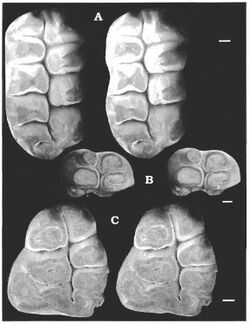Biology:Catopsalis
| Catopsalis | |
|---|---|

| |
| Catopsalis waddleae | |
| Scientific classification | |
| Domain: | Eukaryota |
| Kingdom: | Animalia |
| Phylum: | Chordata |
| Class: | Mammalia |
| Order: | †Multituberculata |
| Superfamily: | †Taeniolabidoidea |
| Genus: | †Catopsalis Cope, 1884 |
| Species | |
| |
Catopsalis is a genus of extinct mammal from the Paleocene of North America. This animal was a relatively large member of the extinct order of Multituberculata. Most Multituberculates were much smaller.
At one time, the genus was also formally reported from the upper Cretaceous of Mongolia. However, that material was subsequently referred to the genera of Djadochtatherium and Catopsbaatar. Catopsalis is within the suborder of Cimolodonta and a member of the superfamily Taeniolabidoidea.
Recent research suggests that "Catopsalis" is actually a paraphyletic assemblage, and one species, C. joyneri, has been moved to its own genus, Valenopsalis.[1]
Species
The species Catopsalis foliatus was named by Cope E.D. in 1882. It has also been known as C. johnstoni (Fox R.C. 1989) and Polymastodon foliatus (Cope 1884). This species has been found in Puercan (Paleocene)-age strata of the San Juan Basin of New Mexico and in the Ravenscrag Formation of Canada. C. johnstoni, from Saskatchewan, is also in the Alberta collection.
The species Catopsalis fissidens was named by Cope E.D. in 1884. It has also been known as C. utahensis (Gazin C.L., 1939) and Polymastodon fissidens (Cope, 1884). It has been found in the Torrejonian (Paleocene)-age beds in the San Juan Basin of New Mexico and Utah. The University of Wyoming boasts a possible specimen.
The species Catopsalis calgariensis was named by Russell L.S. in 1926. Remains were found in Paleocene-age strata of Wyoming and Alberta, Canada. The holotype, collected in 1924, is in the collection of Alberta University. Further material is in the possession of Wyoming University.
The species Catopsalis alexanderi was named by Middleton M.D. in 1982. It is found in the Puercan (Paleocene)-age Littleton Local Fauna of Colorado, Montana and Wyoming (United States), dating from 66 - 63 million years ago. Specimens are included in the collections of the American Museum of Natural History in New York and the Peabody Museum of Natural History at Yale University.
The species Catopsalis waddleae was named by Buckley G.A. in 1995. It has been found in the Puercan age beds of the Simpson Quarry of Montana. Relative to the other species it is an extreme heavyweight. Remains of this species have also recently been discovered in the Idaho panhandle region.
References
- ↑ Thomas E. Williamson, Stephen L. Brusatte, Ross Secord, Sarah Shelley, A new taeniolabidoid multituberculate (Mammalia) from the middle Puercan of the Nacimiento Formation, New Mexico, and a revision of taeniolabidoid systematics and phylogeny, 5 OCT 2015, doi:10.1111/zoj.12336
- Middleton (1982), "A new species and additional material of Catopsalis(Mammalia, Multituberculata) from the western interior of North Am." J. Paleontol. 56, p. 1197-1206.
- Russell (1926), "A new species of the genus CatopsalisCope from the Paskapoo formation of Alberta". Amer. Jour. Sci. 5, p. 230-234, fig. 1.
- Gazin (1939), "A further contribution to the Dragon Paleocene fauna of central Utah". J. Wash. Acad. Sci. 29, p. 273-286, 10 figs.
- Fox (1989), "The Wounded Knee local fauna and mammalian evolution near the Cretaceous-Tertiary boundary, Saskatchewan, Canada". Palaeontogy. Abt. A: Paläozool., Stratigr. 208, p. 11-59 + 6 plates.
- Kielan-Jaworowska Z. and Hurum J.H. (2001), "Phylogeny and Systematics of multituberculate mammals". Paleontology 44, p. 389-429.
Wikidata ☰ Q640821 entry
 |

